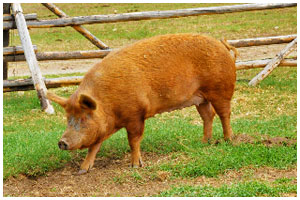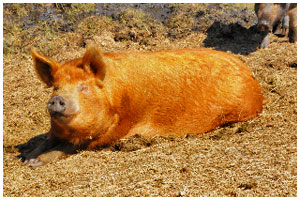Our Breeds: Tamworth Pigs
We think we live in one of the most wild and beautiful parts of the world, but, as a farming operation we are limited by the climate and the soil to growing hay and grass, and so can only keep animals that thrive on that. Which is how we came to Tamworth pigs.
We wanted a pig that would thrive on our tame and wild grasses. A grazing pig. Something with proven success on remote farms and ranches in Canada. Something that wouldn’t burn under our endless sunshine. Something that was hardy and had a reputation for good mothering. And an excellent pork product. So we came to the Tamworth. There are, sadly, very few purebred Tamworths in Canada, and at the time almost none available in western Canada. We finally found a small producer in Ontario who was willing to fly 3 purebred Tamworth gilts to us on commercial airline in the autumn – they came in pet crates and as long as they could see or hear one another were as calm and cheerful as if they flew around the country every weekend.
We had set up a lovely pen for them in the barn but they soon made it clear that they wanted to sleep outside in a pile of hay under the barn eaves – where they could see everything that was going on. And so they have, every night of the year, even on minus 35C nights in March when they disappear into the pile of hay and don’t come out until breakfast is served. They thrive on our grass and are out and about every day even in plus 35C days of mid summer. They are also fed hog grower and rolled barley and surprisingly large amounts of alfalfa hay in winter, to ensure they have a balanced diet, along with their grazing and rooting.
 |
The Tamworth is one of the oldest breeds of pigs, developed in Britain before the introduction of Chinese breeds, when pigs still had long elegant rooting noses. The Tamworth should still have a long straight nose, a slightly dished face and a long body with deep sides. The ears should be large, erect and pointed, contributing to the alert appearance. The mouth is usually curved in an almost permanent “smile”. And its colour, of course, must be the distinct red-gold or ginger, without any black hairs or dark spots.
Tamworths are known for their excellent feet and good skeletal structure, so important to an active grazing pig. Litters are smaller than many commercial breeds but their excellent mothering skills means that few piglets are lost, and they have lots of milk. Perhaps its greatest strength is its tremendous hardiness with respect to climate. Famous for doing well in northern countries like Scotland and Canada, with the ability to retreat to shelter they will thrive in all sorts of weather. There is nothing better than seeing a Tamworth gliding across a field of deep snow on its regular morning promenade, even on Christmas day.
Once cows are accustomed to pigs (Tamworths assume they are welcome everywhere and seem to take very little time making themselves at home) they will graze quite happily together, the Tamworth grazing on that vegetation the cows reject, thus keeping pastures evenly grazed while the cows provide look out and protection for the pigs. The Tamworth shows good conversion on poor pasture and as a result Tamworths are the best choice of pig for forage based operation. In Canada they were considered the “easy keeper” pig. They are truly the ideal pasture pig.
Given the opportunity to stretch their legs, graze and socialize naturally, Tamworths are friendly and social creatures, happy to have the attention of humans.
 |
As Tamworth are such an old breed, and genetically quite distinct from most modern commercial breeds they are considered a good choice for cross breeding.
The Tamworth is sometimes called a “bacon pig” because of its ability to achieve high body mass without having much actual fat. As a grazing pig the meat – both bacon and pork - is tender, flavourful but not fatty. Coloured pig breeds are generally considered more flavourful than the white breeds, and the Tamworth is no exception. The Tamworth will produce pasture raised lean mean of superior quality.
In May 2009, the Tamworth pig was inducted into the Slow Food Ark of Taste in Canada, the eleventh item on the Canadian Ark, and the first pig. Other foods include the Canadienne cow, the Sasktatoon berry and Red Fife wheat. The Tamworth pig was once a more popular breed in Canada but although it adapted well to the rough and tumble life on pioneer farms in Canada it did not adopt well to industrial production so has almost disappeared. This designation will, we hope, educate many Canadians who are interested in good food about the Tamworth and stimulate demand for pork from this wonderful breed.
The Ark of Taste, says Slow Food on its website, “ aims to rediscover, catalog, describe and publicize forgotten flavors. It is a metaphorical recipient of excellent gastronomic products that are threatened by industrial standardization, hygiene laws, the regulations of large-scale distribution and environmental damage.”
Why then did the Tamworth fall out of favour? Coloured pigs lost popularity to white pigs, that were considered a better looking carcass (although less flavourful); the active, social nature of the Tamworth was inappropriate for industrial production where pigs are kept contained in small pens all their lives; lard breed pigs with more fat were preferred to bacon type pigs like the Tamworth and the smaller litter size produced by the Tamworth, despite its good mothering attributes, took it out of the industrial pork scene. It is now listed as “critical” by Rare Breeds Canada, with only 1 to 35 purebreds registered a year.
